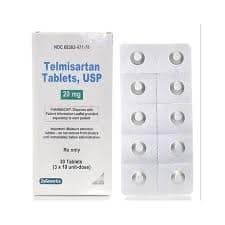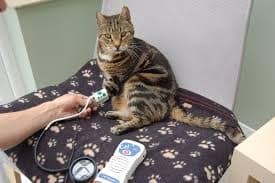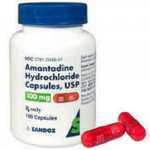Brand Name: Semintra, Micardis

A recent veterinary study suggests that Temisartin may work better than ACEi (Angiotensin Converting Enzyme Inhibitors) for reducing protein loss in the urine.
For companion cats and dogs suffering from proteinuria or hypertension, an ARB (Angiotensin Receptor Blocker) may soon be the drugs of choice.
Background
Telmisartan is in a class of medications known as the ARBs (angiotensin II receptor blockers) that has been used in human medicine since the mid-1990s. Recently, telmisartan received FDA approval to treat high blood pressure in cats but more commonly it is used for inappropriate urinary protein loss (glomerular disease.)
So how does that work and how are those two conditions even related? The answer is angiotensin II, a biochemical designed to maintain your blood pressure in times of blood loss. The problem is that your body thinks that any drop in blood pressure means it should generate angiotensin II. This is great if you are in hand-to-hand combat against a predator, but it’s not great if you are having heart failure. Also, if you have high blood pressure for any of a number of reasons, you don’t need any angiotensin II around making things worse.
Angiotensin II brings up blood pressure in many ways: narrowing blood vessels, generating other hormones, causing sodium to be retained and more. Part of its actions include altering the circulation through the kidneys. More specifically, angiotensin II alters the way blood flows through the nephrons in the kidneys; the nephrons are the function units of the kidneys that are busy filtering out toxins, balancing electrolytes, etc. In diseases where the nephron’s filtration mechanisms are damaged and proteins are inappropriately lost in urine, angiotensin II makes things worse, and inhibiting its actions is helpful. This inhibition is often done with angiotensin converting enzyme inhibitors, such as benazepril, or enalapril). Sometimes these are not enough or the patient does not tolerate them so in these cases ARBs like telmisartan come in handy.

How this Medication is Used
This medication is typically given once a day with or without food. Expect monitoring blood pressure, kidney and electrolyte values as well as urinary protein loss to assess how well the medication is working. Monitoring tests will be on-going so be sure you understand the schedule your veterinarian has recommended.
Side Effects
The full side effects profile is still being worked out for pets. Low blood pressure (manifesting as weakness or even fainting) is possible with any medication that reduces blood pressure.
Upset stomach (vomiting, diarrhea, appetite loss) should be reported to your veterinarian if persistent.
Telmisartan is not considered to be safe in pregnancy and should not be handled by pregnant women (wear gloves and wash hands after touching).
Interactions with other Drugs
Concurrent use of telmisartan with many sedating medications can amplify the sie effects of low blood pressure. Like with any medication, check with your veterinarian to make sure compatability has been checked.
If telmisartan is used with non-steroidal anti-inflammatory medications, monitoring of kidney function becomes even more important and the test interval may become more frequent.
Concerns And Cautions
The biggest concerns stems from the newness of this medicine in veterinary practice. The side effects potential is still being described. That said, the recent study performed was promising and showed better results with this ARB than with our currently more used ACE inhibitors. Some veterinarians are starting to use telmisartan first. Over time, this drug or class of drugs may replace what’s currently being used.


